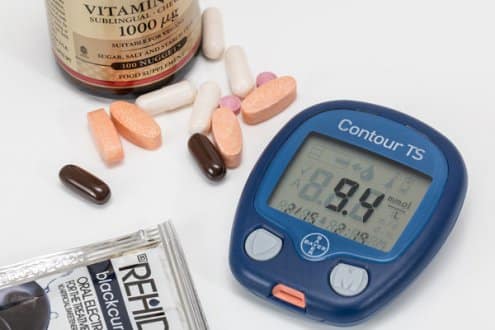Understanding pioglitazone mechanism of action helps you explain why this medication improves insulin sensitivity. It works at the gene level to change how fat, muscle, and liver cells handle glucose and lipids. This matters because better insulin signaling can reduce A1C without pushing the pancreas to make more insulin.
Key Takeaways
- Insulin sensitizer: Improves response in adipose, muscle, and liver.
- Main risks: Fluid retention, weight gain, fractures, and rare liver injury.
- Not for type 1 diabetes or diabetic ketoacidosis.
- Start low, titrate slowly; monitor edema and heart status.
- Combine thoughtfully with metformin or SGLT2/GLP-1 agents.
How Pioglitazone Works: pioglitazone mechanism of action
Pioglitazone activates the nuclear receptor PPAR-gamma (peroxisome proliferator-activated receptor gamma). Once activated, this receptor changes gene transcription, shifting fat storage to subcutaneous depots and improving adipokines such as adiponectin. The result is less circulating free fatty acids and improved insulin signaling in muscle and liver.
Clinically, these changes increase glucose uptake in skeletal muscle and reduce hepatic gluconeogenesis. Over weeks, that can lower fasting glucose and A1C. For a broader overview of receptor-level effects, see Actos Mechanism Overview for related context.
Regulatory summaries describe these mechanisms and key class effects in the FDA prescribing information for pioglitazone (FDA prescribing information). A patient-facing summary is available through the MedlinePlus overview.
Pharmacology and Drug Class
Pioglitazone belongs to the thiazolidinedione group, often called the pioglitazone class. These agents act mainly through PPAR-gamma, with modest effects on PPAR-alpha. Brand formulations have included Actos; many regions now rely on generic versions.
Unlike insulin secretagogues, thiazolidinediones do not force insulin release. They improve tissue responsiveness instead. For a structured comparison with other agents, review Common Diabetes Medications for mechanism contrasts and combination planning.
Note: This medicine is not approved for type 1 diabetes or for treating diabetic ketoacidosis. It provides no immediate glucose-lowering effect during acute metabolic crises.
Indications and Clinical Scenarios
Approved pioglitazone indications focus on adults with type 2 diabetes, as monotherapy or in combination with other antihyperglycemics. It supports diet and exercise when insulin resistance is a major driver of hyperglycemia. Clinicians may consider it in patients where hypoglycemia avoidance is a priority, particularly when used without insulin or sulfonylureas.
Some specialists use it off-label in metabolic dysfunction–associated steatotic liver disease (MASLD/NAFLD), especially when biopsy-proven steatohepatitis is present. Evidence suggests histologic improvements in select patients, though careful risk–benefit discussions are essential. For broader management context, see Type 2 Diabetes for linked care pathways and monitoring themes.
Dosing and Administration
Treatment is individualized. Typical approaches start low and titrate based on A1C, glucose patterns, and tolerability. Many clinicians begin with 15–30 mg once daily and adjust after several weeks. The pioglitazone dose per day should reflect comorbidities, edema risk, and combination therapy. Published labels set a maximum daily dose; dosing above labeled thresholds, such as pioglitazone 60 mg daily, is not recommended.
Combination therapy is common. Pairing with metformin can address both insulin resistance and hepatic glucose production. For metformin specifics and titration considerations, see Glumetza for extended-release approaches. When combining with DPP-4 inhibition plus metformin, Janumet XR provides a reference for fixed-dose options and GI tolerability considerations.
Tip: Reassess edema, weight, and blood pressure at each titration step. Slower uptitration may reduce fluid-related adverse effects.
Safety Profile and Warnings
The most notable pioglitazone side effects include edema, weight gain, and increased fracture risk, particularly in postmenopausal women. Macular edema and rare hepatotoxicity have been reported. When used with insulin or sulfonylureas, hypoglycemia can occur more often, so dose adjustments of the companion drug may be needed.
Pioglitazone can worsen or precipitate heart failure due to fluid retention. Monitor for dyspnea, rapid weight gain, and edema. Regulatory guidance highlights this risk and advises careful patient selection; see the FDA prescribing information for boxed warnings and monitoring notes. For practical strategies to minimize low sugar events, see Actos and Hypoglycemia for counseling points and symptom review.
Some observational data suggested a bladder cancer signal; subsequent analyses offer mixed findings. If patients have active bladder cancer or unexplained hematuria, consider alternatives and evaluate further. A patient-friendly safety overview is available through the MedlinePlus overview.
Liver and Weight Considerations
Clinicians should be aware of pioglitazone side effects on liver, even though clinically significant injury is uncommon. Obtain baseline liver enzymes and reassess if symptoms such as unusual fatigue, anorexia, right upper quadrant pain, or dark urine appear. Routine periodic liver testing in asymptomatic patients is not universally required but remains reasonable when risk factors exist.
Weight gain is dose-related and often reflects increased subcutaneous fat and fluid retention. This may be acceptable if A1C falls and cardiometabolic risk factors improve elsewhere, but it can frustrate patient adherence. Where weight control is essential, pair or switch to agents with neutral or negative weight effects. The American Diabetes Association’s Standards of Care in Diabetes discuss balancing glycemic and weight outcomes across classes.
Special Populations and Contraindications
The label highlights pioglitazone contraindications heart failure, particularly NYHA Class III–IV. Even in milder heart failure or significant edema, careful monitoring is needed. Older adults may be more sensitive to fluid shifts and fractures, so fall risk and bone health should be part of routine assessments.
Renal impairment does not significantly alter drug exposure; however, concurrent insulin or diuretic use can complicate volume status. Hepatic impairment requires caution, especially with elevated transaminases. For comparative context when tailoring regimens, see Actos vs. Metformin to review differential benefits in insulin resistance versus GI tolerability and weight considerations.
Practical Use and Timing
Patients often ask about pioglitazone before or after food. It can be taken with or without meals, ideally at the same time each day for consistency. Counsel patients to monitor for swelling, shortness of breath, and rapid weight changes, especially after dose increases.
When starting at 15 mg, some individuals report fewer early side effects, while higher initial doses may increase edema and weight gain. Encourage daily step counts, sodium moderation, and periodic self-checks for ankle swelling. These simple measures can help surface fluid retention earlier and guide timely follow-up.
Compare and Combine With Other Therapies
Pioglitazone fits best when insulin resistance is prominent and hypoglycemia avoidance matters. SGLT2 inhibitors complement its profile by promoting urinary glucose excretion and offering cardiorenal benefits. For SGLT2 background and combination choices, see Dapagliflozin to align on mechanisms and outcome data summaries. Fixed-dose canagliflozin/metformin combinations may also be considered; see Invokamet for formulation details and renal dosing thresholds.
Some patients ultimately need basal or prandial insulin. For concentrated basal options and dose-consolidation scenarios, see Toujeo Doublestar Prefilled Pen for pharmacokinetic context and titration principles. When rapid mealtime coverage is required, see Humalog Cartridge 100 Units Ml for onset and duration characteristics before adjusting meal plans. For a broad class overview that includes injectables, see Oral Diabetes Medications as a primer and stepping stone to add-on therapies.
Recap
Pioglitazone is an insulin sensitizer that acts through PPAR-gamma to improve glucose handling in fat, muscle, and liver. It can lower A1C without directly stimulating insulin release, but it carries fluid retention, weight, and fracture risks. Careful selection, slow titration, and ongoing monitoring help balance benefits and harms over time.
When mechanisms, comorbidities, and patient goals align, thiazolidinediones can be a useful part of a comprehensive plan. Revisit therapy at regular intervals and coordinate with other lifestyle and pharmacologic strategies.
This content is for informational purposes only and is not a substitute for professional medical advice.



